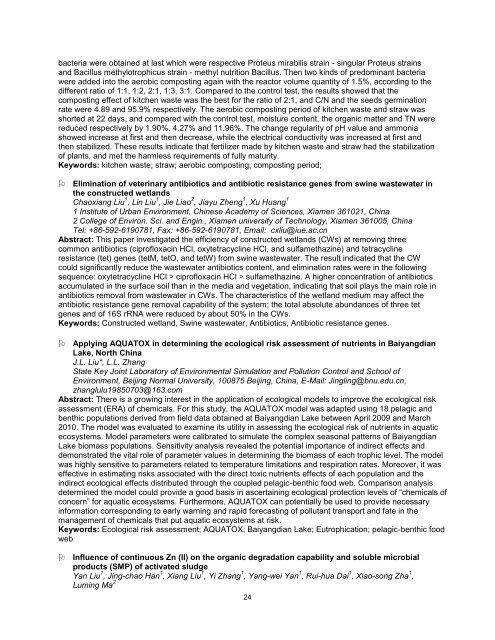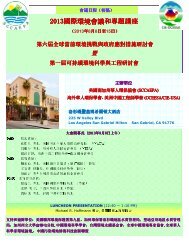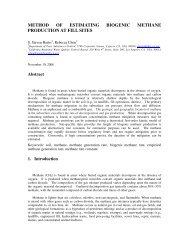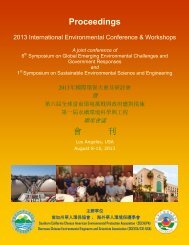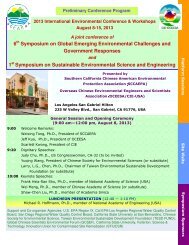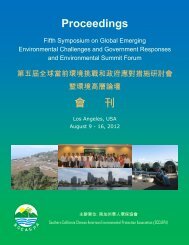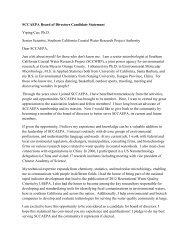Proceedings æ å - SCCAEPA SPONSORS
Proceedings æ å - SCCAEPA SPONSORS
Proceedings æ å - SCCAEPA SPONSORS
Create successful ePaper yourself
Turn your PDF publications into a flip-book with our unique Google optimized e-Paper software.
acteria were obtained at last which were respective Proteus mirabilis strain - singular Proteus strains<br />
and Bacillus methylotrophicus strain - methyl nutrition Bacillus. Then two kinds of predominant bacteria<br />
were added into the aerobic composting again with the reactor volume quantity of 1.5%, according to the<br />
different ratio of 1:1, 1:2, 2:1, 1:3, 3:1. Compared to the control test, the results showed that the<br />
composting effect of kitchen waste was the best for the ratio of 2:1, and C/N and the seeds germination<br />
rate were 4.89 and 95.9% respectively. The aerobic composting period of kitchen waste and straw was<br />
shorted at 22 days, and compared with the control test, moisture content, the organic matter and TN were<br />
reduced respectively by 1.90%, 4.27% and 11.96%. The change regularity of pH value and ammonia<br />
showed increase at first and then decrease, while the electrical conductivity was increased at first and<br />
then stabilized. These results indicate that fertilizer made by kitchen waste and straw had the stabilization<br />
of plants, and met the harmless requirements of fully maturity.<br />
Keywords: kitchen waste; straw; aerobic composting; composting period;<br />
Elimination of veterinary antibiotics and antibiotic resistance genes from swine wastewater in<br />
the constructed wetlands<br />
Chaoxiang Liu 1 , Lin Liu 1 , Jie Liao 2 , Jiayu Zheng 1 , Xu Huang 1<br />
1 Institute of Urban Environment, Chinese Academy of Sciences, Xiamen 361021, China<br />
2 College of Environ. Sci. and Engin., Xiamen university of Technology, Xiamen 361005, China<br />
Tel: +86-592-6190781, Fax: +86-592-6190781, Email: cxliu@iue.ac.cn<br />
Abstract: This paper investigated the efficiency of constructed wetlands (CWs) at removing three<br />
common antibiotics (ciprofloxacin HCl, oxytetracycline HCl, and sulfamethazine) and tetracycline<br />
resistance (tet) genes (tetM, tetO, and tetW) from swine wastewater. The result indicated that the CW<br />
could significantly reduce the wastewater antibiotics content, and elimination rates were in the following<br />
sequence: oxytetracycline HCl > ciprofloxacin HCl > sulfamethazine. A higher concentration of antibiotics<br />
accumulated in the surface soil than in the media and vegetation, indicating that soil plays the main role in<br />
antibiotics removal from wastewater in CWs. The characteristics of the wetland medium may affect the<br />
antibiotic resistance gene removal capability of the system; the total absolute abundances of three tet<br />
genes and of 16S rRNA were reduced by about 50% in the CWs.<br />
Keywords: Constructed wetland, Swine wastewater, Antibiotics, Antibiotic resistance genes.<br />
Applying AQUATOX in determining the ecological risk assessment of nutrients in Baiyangdian<br />
Lake, North China<br />
J.L. Liu*, L.L. Zhang<br />
State Key Joint Laboratory of Environmental Simulation and Pollution Control and School of<br />
Environment, Beijing Normal University, 100875 Beijing, China, E-Mail: Jingling@bnu.edu.cn,<br />
zhanglulu19850703@163.com<br />
Abstract: There is a growing interest in the application of ecological models to improve the ecological risk<br />
assessment (ERA) of chemicals. For this study, the AQUATOX model was adapted using 18 pelagic and<br />
benthic populations derived from field data obtained at Baiyangdian Lake between April 2009 and March<br />
2010. The model was evaluated to examine its utility in assessing the ecological risk of nutrients in aquatic<br />
ecosystems. Model parameters were calibrated to simulate the complex seasonal patterns of Baiyangdian<br />
Lake biomass populations. Sensitivity analysis revealed the potential importance of indirect effects and<br />
demonstrated the vital role of parameter values in determining the biomass of each trophic level. The model<br />
was highly sensitive to parameters related to temperature limitations and respiration rates. Moreover, it was<br />
effective in estimating risks associated with the direct toxic nutrients effects of each population and the<br />
indirect ecological effects distributed through the coupled pelagic-benthic food web. Comparison analysis<br />
determined the model could provide a good basis in ascertaining ecological protection levels of “chemicals of<br />
concern” for aquatic ecosystems. Furthermore, AQUATOX can potentially be used to provide necessary<br />
information corresponding to early warning and rapid forecasting of pollutant transport and fate in the<br />
management of chemicals that put aquatic ecosystems at risk.<br />
Keywords: Ecological risk assessment; AQUATOX; Baiyangdian Lake; Eutrophication; pelagic-benthic food<br />
web<br />
Influence of continuous Zn (II) on the organic degradation capability and soluble microbial<br />
products (SMP) of activated sludge<br />
Yan Liu 1 , Jing-chao Han 1 , Xiang Liu 1 , Yi Zhang 1 , Yang-wei Yan 1 , Rui-hua Dai 1 , Xiao-song Zha 1 ,<br />
Luming Ma 2<br />
24


